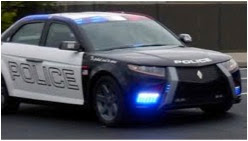1. KNOW WHAT THE COPS ARE DRIVING: Get to
recognize the profile of a police cruiser, front, side, and back, headlights
and taillights. Remember that nowadays, police cars are not just big hefty sedans. My friends over at the California Highway Patrol recently announced that the Ford Explorer will eventually be their official radio car. Very soon all Crown
Victorias will be retired to private civ-use and Livery Land, a taxi coming
to the nearest location near you. Cop rides now also come in the form of smaller
sedans, hybrids, station wagons, crossovers, and SUV’s, even sports cars, and
soon even all-electric cars. I’m starting to see some agencies replace three
wheeled Cushman scooters
with Smart-like
micro-cars and/or Prii.
The automotive industry is currently redefining what a police car is or should be. The industry is now recognizing that if the military has purpose-built vehicles, why not the police? A start-up company called Carbon Motors will (hopefully) soon produce a sole purpose-built customized bespoke tricked-and-pimped-out cop car called the E7 only the cops can use and no one else. The car is cleverly designed, with a BMW turbocharged diesel engine, suicide doors, and other than its markings in the daylight, it’s hard to make out as a cop car at night with its emergency lights built-in to the frame and off. When the car is decommissioned at the end of its police service, it will be returned to Carbon Motors for recycling, and not to Livery Land for extended reuse. At GM, Chevrolet just resurrected the famous Caprice moniker as their answer to Carbon Motors; called the Chevrolet Caprice Police Patrol Vehicle (PPV). It is assembled in Australia and built exclusively for the police with a steroided V-8. Don’t forget my old standby and favorite, motorcycles. Even scooters are getting faster as of late. As far as colors, police jargon calls them unmarked, marked, plain wrapper, a black and white, blue top, white top, black top, or even a flat top (no light bar on the roof but still marked, an excellent profile for speed enforcement). The light on the dash is called either a “fireball” or an FBI light. Lights that alternately flash are called “wig wags,” and recent halogen and LED technology has made emergency vehicle lighting quite spectacular. Know what the police look like on the road, before they find you . . .










0 comments:
Post a Comment
Sgt. Al here. I welcome your comments, ideas, and suggestions. You have questions about the police, and I'm interested in hearing what you have to say as a citizen. Thanks!